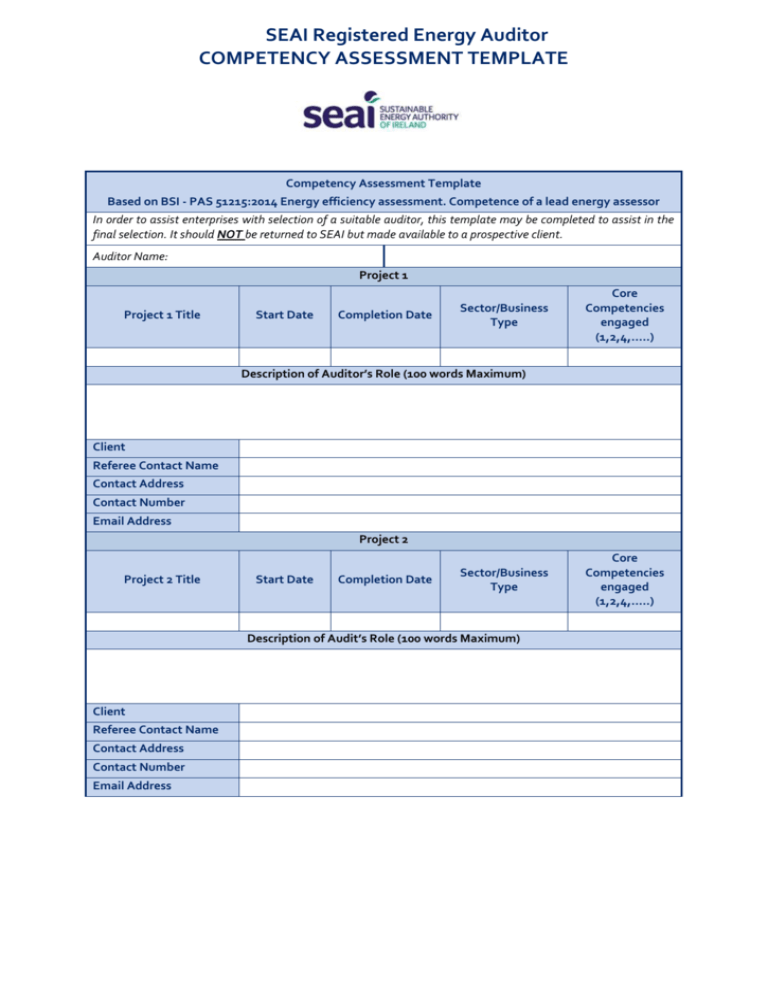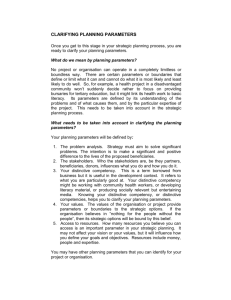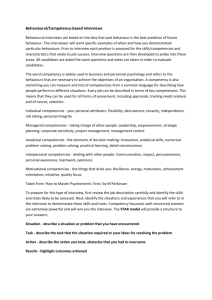Competencies Assessment Template (size 47 KB)
advertisement

SEAI Registered Energy Auditor COMPETENCY ASSESSMENT TEMPLATE Competency Assessment Template Based on BSI - PAS 51215:2014 Energy efficiency assessment. Competence of a lead energy assessor In order to assist enterprises with selection of a suitable auditor, this template may be completed to assist in the final selection. It should NOT be returned to SEAI but made available to a prospective client. Auditor Name: Project 1 Project 1 Title Start Date Completion Date Sector/Business Type Core Competencies engaged (1,2,4,…..) Description of Auditor’s Role (100 words Maximum) Client Referee Contact Name Contact Address Contact Number Email Address Project 2 Project 2 Title Start Date Completion Date Sector/Business Type Description of Audit’s Role (100 words Maximum) Client Referee Contact Name Contact Address Contact Number Email Address Core Competencies engaged (1,2,4,…..) COMPETENCY ASSESSMENT TEMPLATE Project 3 Project 2 Title Start Date Completion Date Sector/Business Type Core Competencies engaged (1,2,4,…..) Description of Audit’s Role (100 words Maximum) Client Referee Contact Name Contact Address Contact Number Email Address Project 4 Project 2 Title Start Date Completion Date Sector/Business Type Core Competencies engaged (1,2,4,…..) Description of Audit’s Role (100 words Maximum) Client Referee Contact Name Contact Address Contact Number Email Address Doc Ref: SEAI Core competencies Template Ver 001 08 06 2015 2 COMPETENCY ASSESSMENT TEMPLATE Competencies Ref 1 2 3 4 5 Competency Area Understanding operational context of the organisation being assessed. Familiarity with, and ability to apply, the requirements of energy efficiency assessment methods. Example of Competence (overwrite the text below) Analysing energy use, energy consumption and energy efficiency. Identifying trends, anomalies, and investigating the reasons for anomalies, where practicable. Where the appropriate and relevant, complementing the analysis with energy benchmark data. Identifying and quantifying variables influencing energy consumption and energy efficiency. Identifying and calculating energy performance indicators for the organisation and/or the scope of the energy efficiency assessment. This could include data from external as well as internal sources, for example, the interpretation and scrutiny of energy billings and anomalies in such data sources. Using collected energy data, and other relevant data, to understand energy use in order to identify opportunities for improvement. Using the relevant technical and non-technical knowledge and skills to check any assumptions made, explain the energy data, and check the applicability of identified opportunities for improvement. Developing a concept and cost for the potential implementation of opportunities. Working with clients/organisation/other internal personnel to: Scoping an energy efficiency assessment, as applicable to the organisation being assessed. Understanding, in detail, energy use and energy systems applicable to the organisation being assessed. Managing energy efficiency assessment team budgets Identify the different groups in organisations that can have an effect on energy consumption; Identify the diversity of expertise, knowledge, skills and attitudes required to achieve an improvement in energy performance; Establish two-way communication with all of the identified groups of ideas, and to engage the different groups to implement energy efficient behaviours. Producing a technical and non-technical energy efficiency assessment report. Producing a business case for improving energy performance. Making presentations of energy efficiency assessment findings to both technical and non-technical staff in the organisation being assessed. Analysing energy use, energy consumption and energy efficiency. Identifying trends, anomalies, and investigating the reasons for anomalies, where practicable. Where the appropriate and relevant, complementing the analysis with energy benchmark data. Identifying and quantifying variables influencing energy consumption and energy efficiency. Identifying and calculating energy performance indicators for the organisation and/or the scope of the energy efficiency assessment. This could include data from external as well as internal sources, for example, the interpretation and scrutiny of energy billings and anomalies in such data sources. Doc Ref: SEAI Core competencies Template Ver 001 08 06 2015 3 COMPETENCY ASSESSMENT TEMPLATE 6 7 8 9 10 Understanding the techniques of measuring, sampling, sub-metering and establishing an energy balance. Using collected energy data, and other relevant data, to understand energy use in order to identify opportunities for improvement. Using the relevant technical and non-technical knowledge and skills to check any assumptions made, explain the energy data, and check the applicability of identified opportunities for improvement. Developing a concept and cost for the potential implementation of opportunities. Working with clients/organisation/other internal personnel to: Data interpretation, including analysis and scrutiny of energy use, energy consumption, and energy performance data. Identification, quantification, ranking and prioritising of opportunities for improvement. Managing working relationships. Familiarity with, and ability to apply, the requirements of energy efficiency assessment methods. Identify the different groups in organisations that can have an effect on energy consumption; Identify the diversity of expertise, knowledge, skills and attitudes required to achieve an improvement in energy performance; Establish two-way communication with all of the identified groups of ideas, and to engage the different groups to implement energy efficient behaviours. Producing a technical and non-technical energy efficiency assessment report. Producing a business case for improving energy performance. Making presentations of energy efficiency assessment findings to both technical and non-technical staff in the organisation being assessed. Analysing energy use, energy consumption and energy efficiency. Identifying trends, anomalies, and investigating the reasons for anomalies, where practicable. Where the appropriate and relevant, complementing the analysis with energy benchmark data. Identifying and quantifying variables influencing energy consumption and energy efficiency. Identifying and calculating energy performance indicators for the organisation and/or the scope of the energy efficiency assessment. This could include data from external as well as internal sources, for example, the interpretation and scrutiny of energy billings and anomalies in such data sources. Using collected energy data, and other relevant data, to understand energy use in order to identify opportunities for improvement. Using the relevant technical and non-technical knowledge and skills to check any assumptions made, explain the energy data, and check the applicability of identified opportunities for improvement. Developing a concept and cost for the potential implementation of opportunities. Doc Ref: SEAI Core competencies Template Ver 001 08 06 2015 4







